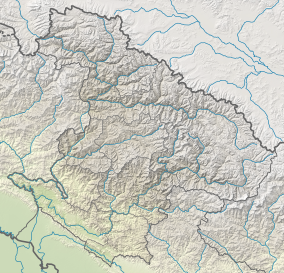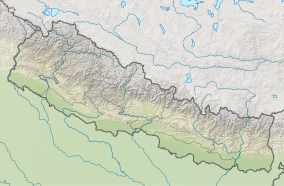Rara National Park
| Rara National Park | |
|---|---|
 Rara Lake | |
| Location | Nepal |
| Nearest city | Jumla |
| Coordinates | 29°30′N 82°04′E / 29.500°N 82.067°E |
| Area | 106 km2 (41 sq mi) |
| Established | 1976 |
| Governing body | Department of National Parks and Wildlife Conservation |


Rara National Park is a protected area in the Himalayas of Nepal and was established in 1976. Covering an area of 106 km2 (41 sq mi) in the Mugu and Jumla districts, it is the country's smallest national park.[1] Its main feature is Rara Lake at an altitude of 2,990 m (9,810 ft).[2] The park was established to protect the unique flora and fauna of the Humla–Jumla Region of Nepal.
The park ranges in elevation from 2,800 m (9,200 ft) to 4,039 m (13,251 ft) at Chuchemara Peak on the southern side of Rara Lake. On the northern side, the peaks of Ruma Kand and Malika Kand frame the alpine freshwater lake, which is the largest lake in Nepal with a surface of 10.8 km2 (4.2 sq mi) and a maximum depth of 167 m (548 ft). It is oval-shaped with an east–west axis, a length of 5 km (3.1 mi) and a width of 3 km (1.9 mi) draining into the Mugu-Karnali River via Nijar Khola.[2]
Rara National Park is managed by the Department of National Parks and Wildlife Conservation and protected with the assistance of the Nepal Army.
Climate
The climate of Rara National Park is pleasant during the summer, but becomes very cold during the winter, because of the altitude. The best times to visit the park are in September, October, April, and May. During the winter, temperatures drop below freezing, and many high passes become blocked by snow.[3] The summer is warm, but June to August is monsoon season, making the trek to Rara National Park difficult.[4]
Vegetation
Rara National Park is rich in flora and fauna, with 1,070 plant species known to occur in the park. The vegetation is generally temperate and subalpine, and is dependent on the altitude.
Fauna
51 species of mammals reside in the park including
There are 241 recorded species of birds, including 49 wetland species.
In 1979, three endemic
Tourism
GORP founder Bill Greer described Rara Lake as:
- "a shimmering blue jewel set in a ring of snowy peaks"[7]
Another travel writer describes a trek in the park:
- "Although more trampled than in the past, the road to Rara Lake is still without any of the comfortable services available along more popular trails. Logistically it is not an easy trek; it is hard to get to and from, and it is an organizational challenge, requiring informed guides and porters to tote the two weeks' worth of material that will keep you warm, dry and fed. It is also tough on the bones, involving several 11,000-foot passes. However, once you overcome the obstacles, the rewards are legion: few if any other trekkers, incomparable natural splendor, "untouched" villages, blissful quiet…"[7]
Environmental issues
Due to over-grazing and defecation, the national park conservation officers are facing a challenge to preserve the lake. Local people are found cutting timber wood and fuel wood, which is a problem for conservation of Rara. Also during festivals visitors and local people produce a lot of wastage causing water pollution.[8]
Transport
Even though the park does not have connection to the national road network, there are two ways to reach Rara National Park- airways and roadways. Roadways, it takes four days to reach Rara National Park from Kathmandu through the Karnali Highway and takes up to three days from the nearest town
References
- Protected Planet. Retrieved 5 January 2022.
- ^ ISBN 978-92-9115-033-5.
- ^ Khadka, M. (n.d.). "Study of Himalayan Lakes in Nepal" (PDF).
{{cite journal}}: Cite journal requires|journal=(help) - ^ "Rara National Park".
- ^ Terashima, A. (1984) Three new species of the Cyprinid genus Schizothorax from Lake Rara, Northwestern Nepal. Japanese Journal of Ichthyology Vol. 31, No. 2: 122–135
- ^ Dubois, A., Matsui, M. (1983). A new species of frog (Genus Rana, Subgenus Paa) from western Nepal (Amphibia: Anura). Copeia: 895–901.
- ^ a b Gelber, E. Top Ten Treks in the Nepalese Himalaya
- ^ Upadhyay, S.; Chalise, L. & Paudel, R. P. (2009). "High Altitude Ramsar Sites of Nepal". The Initiation: 135–148.
- ^ आरके अदिप्त गिरी. "रारा की अप्सरा ! ( फोटो फिचर)". annapurna post (in Nepali). Retrieved 2022-07-21.
- ^ Niraula, Sujan. "Rara or Apsara...? (Photo feature)". Online Khabar (in Nepali). Retrieved 2022-07-21.


